#artist who knows nothing about scenic arts attempts to draw one..
Text
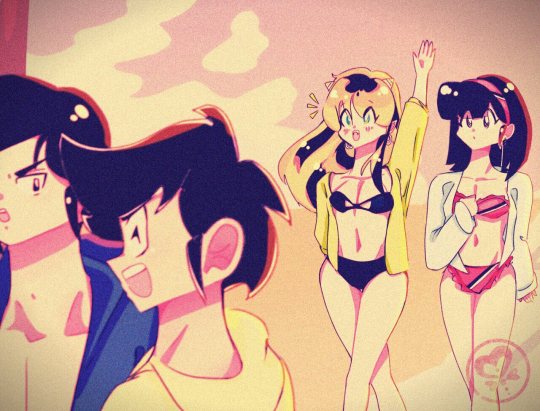
Have art of the gang @ the beach.. ☀
#artist who knows nothing about scenic arts attempts to draw one..#posting it cuz i think it looks good enough to post#urusei yatsura#うる星やつら#urusei yatsura 2022#lum#ataru moroboshi#shinobu miyake#shutaro mendo#god i love them sm#my art#yucaillusts#uy quartet#uy posting
49 notes
·
View notes
Text
Sailor Moon 90s Anime is STILL the best
Hi. I know I am on a Sailor Moon binge here, but after seeing all of Crystal, Eternal and on R (season 2) of the first anime, I want to get this all off of my chest... and before I go further, since these are all animes, I will refer to them as 90s, Crystal and Eternal. And after watching them all, I have to say that the 90s takes the gold medal as the best Sailor Moon anime so far and this is why;
1- It had the best pacing. - While I admit that sometimes, it went too far with the filler, 98% of the time, it worked with the 90s. It took its time to make you get to know the characters for better or for worse, it made you see different sides of them, it gave them a chance to truly develop and be multi-dimensional, and it made you care about them. When a death happened, it felt tragic. When a victory happened, you cheered. And when you saw what side characters did, it mattered. I mean, who can ever forget the contribution 90s Naru Osaka had to the story? And everyone who has seen the 90s anime cannot forget her. More on the character development and getting to know characters later.

Sure, it wasn’t true to the manga and even the characters had different personalities, but I let that slide by because when Crystal and Eternal did follow the manga to the letter, we didn’t get a chance to digest anything. The only characters who develop are Usagi, Chibi-Usa and the outer guardians, and for the last bunch, it was the bare minimum. Crystal and Eternal were fun rides and I would be lying if I said I didn’t like them, but they were like roller coasters. They gave you a thrill, but fast and been done. The 90s was like a slow scenic ride that gave you surprises, emotionally touched you, made you cry, made you laugh, made you root for the heroes and even at the age of 37 years now, I keep rewatching this series.
2- The art of the 90s was better because it was sketchy, dark and edgier. - I know Sailor Moon doesn’t seem like this on the surface because the heroines are lovely girls in cute costumes, it emphasizes femininity and all things pretty, it has a romantic theme and is all about love, but Sailor Moon is also one of the darkest, grittiest, edgy and violent magical girl animes I have ever seen since Magic Knights Rayearth. Sailor Moon has on screen deaths which were permanent most of the time, on screen stabbings and the drawing of blood, and fights that got so hardcore, that real punches and kicks were thrown. The dark edges, black line art and sharp edges worked with the atmosphere of the story. I mean, look at the difference between the halls Dark Kingdom of the 90s (above) and that of Crystal.


And if that is not enough to win you over, the characters were much more animated, organic and conveyed more emotion whether they were exaggerated or serious.
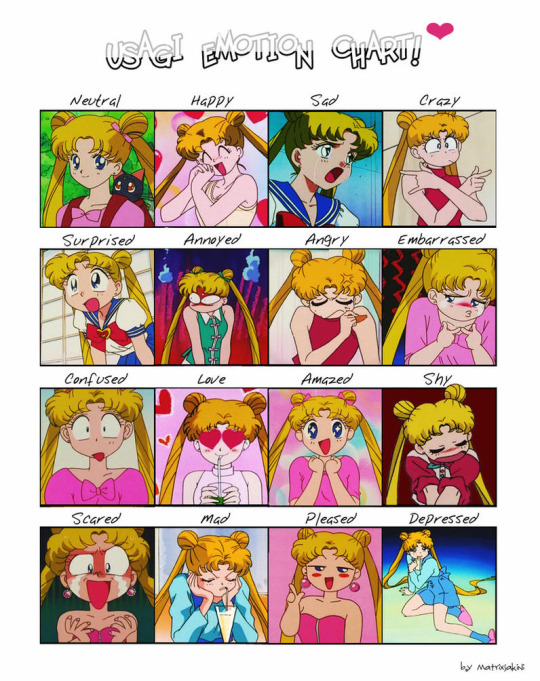
In Crystal, the expressions and body language was very dulled down. Not to mention, very stiff.

Everything is also too bright and soft which makes the characters look like velvet dolls with too much make up especially with the line art. I will give them props for adding better details, cleaner lines, the glow of magical items, and details in the gems, but everything else is all wrong.

Eternal was better, but still not quite there. The colours are still way too bright and the characters still look too much like dolls from having line art that is too wispy. And I really do not like how the eyes have this unnatural glow to them. The edgy scenes become lost with all this brightness.

3- We got to see that there was so much more the characters than just heroes or villains. - Since Usagi is the titular character, let us just talk about her in the 90s since I could go on forever about how much we learned about the characters. In any version of Sailor Moon, Usagi’s role as a Sailor Guardian has always been the core of the story and she does indeed show progress as one. However, the 90s tells us that no matter what, she is still going to be herself too which is just as important and she shows character development as just plain old Usagi too. The manga, Crystal and Eternal which only paint Usagi as not doing anything right except be a Sailor Guardian, but the 90s show her hidden talents and learning new skills. For example, she was bad at cooking at the beginning of the series.
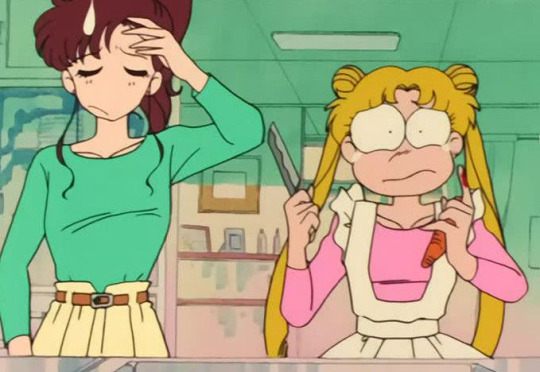
However, by Sailor Moon R, she gets the hang of it and is able to cook a meal by herself. Yes, she is messy, clumsy, never gets the hang of making cookies and is nowhere near Makoto’s level especially when it comes to presentation, but she is good at cooking food.

Another hidden talent of Usagi’s is her drawing skills. She isn’t just good at drawing. She’s got talent at it, so in the 90s, Usagi is quite the artist.

And it is admirable that 90s Usagi is open to trying new things even if she isn’t good at them. She practices, she explores and tries to enlighten herself. Sure, academics, coordination and organization will never be her fortes, but she really does have other and tries to discover more.

In Crystal and Eternal, she is good at being Sailor Moon, she is a good friend and a good girlfriend, but that is it. She is one dimensional here and she isn’t the only one to painted like that. Everyone is only the obvious and that is all the audience gets.
4- Better character redemption. - I mentioned before that Sailor Moon had grit and was dark, but the 90s also made it more complex and did character redemption right. It was open to the possibility of bad people becoming good. For instance, the Black Moon Clan Specter Sister are unforgettable for being successfully redeemed.
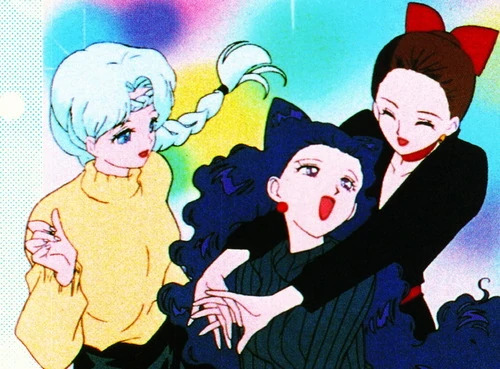
Yes, I admit that the monster of the day would get killed by the hands of the Sailor Guardians, but they also clearly showed that the monsters were not people or even alive. They were made of energy, clay or sand. When the monster of the day was a possessed innocent, they were saved through exorcism. Very rarely was an actual person ever killed and even when they were, it was either by the hands of another villain, their own hand, self defense or as a last resort. They never used killing as means of dealing with every single bad guy.

Furthermore, the bridge arc about the Makai Tree that also served as a prologue to Sailor Moon R could be seen as a story about mercy, kindness and love. It stands out as the one time the big bad was actually a misunderstood big good being the Makai Tree herself. And even Ail an An were never bad, but were raised bad. And even then, they changed. This story is unique only to the 90s so far, but it was great and stood out for that reason.
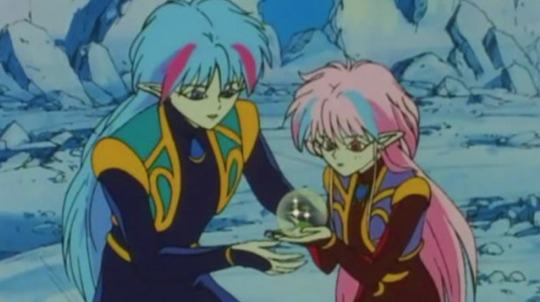
In Crystal, the heroines will kill a person without a second thought which I am shocked that no one brings up how repetitive and contradictory that is. The pretty warrior of love and justice should by all means protect the Earth, but doing so by killing off the bad guy all time is not love or justice. I also think the caption in this picture sums up how I feel about how the one and only time bad guys were given a chance to be redeemed...

Eternal was better because the Asteroid Guardians got redeemed and saved. However, even then, I feel like there is still a double standard. They were one of the good guys to begin with and Sailor Guardians. In the 90s, the Amazoness Quartet wasn’t, but were given a chance to change anyway. I find it cool that the Quartet turned out to be Sailors and even better that they will go on to become Chibi-Usa’s team, but mercy is not just for your allies or for your own benefit. Everyone should be given at least one chance to fix their mistakes.

5- We got to know Mamoru better. - I admit that no matter the incarnation, Tuxedo Mask will never be as powerful as Sailor Moon except when he is King Endymion, but the 90s take on his character made him better even if they did omit his super attack being Tuxedo le Smoking Bomber. What the well dressed masked man lacked in firepower, he made up for in intelligence, insight about the enemy’s weakness, courage and skill. The only times he ever did get overpowered was either by bad luck or because it was intentional because he was taking a hit for Sailor Moon. And even then, he always got back up. He’s a real man like that.
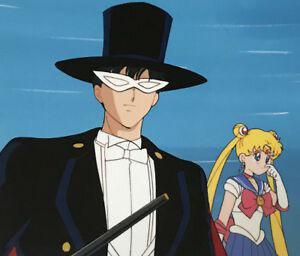
More importantly, we get to know him as Mamoru too. Even before he confides being an amnesiac to Usagi, we see his struggles with feeling alone in the world from having no memory of his life before a tragic accident which also killed his parents. Now, him being a stern cynical person makes sense because I probably wouldn’t be pleasant to be around either if I lived with that. Once his walls come down, we see that deep down, all he wants is to belong somewhere and have a family. It should also be noted that 90s Mamoru doesn’t love Usagi because he is “destined” to. He loves her because he wants to. Even during that brief period where he broke up with Usagi was an act of love. The thing I also always liked best about 90s Mamoru is that even though he loves Usagi more than life itself, his life doesn’t revolve around her which is a healthy thing and he tries to encourage Usagi to be the same way for her own good. He is studying to be a doctor, he has a job and he even has his own crowd which I think is great.

In Crystal and Eternal, while I do see an attempt at trying to follow this trend by showing that Usagi and Mamoru were on their way to falling in love even before they got their memories back, I still find he was one note and we never really learn much about him that has nothing to do with Tuxedo Mask, Endymion or anything royal related. Sure, we know that he’s studying to be a doctor and is a genius to an extent too, but that is it.

I would like to end this by admitting that the 90s was not perfect either, but out of all the takes on the tale of Sailor Moon as of date. Crystal and Eternal were ok, but they just cannot stand up to the quality of the 90s. The only thing I can say I find Crystal did better than the 90s were the costume designs. Specifically, how they let Venus keep her chain belt, Pluto’s key chain belt, Uranus and Neptune’s shorter gloves, Uranus’s sword, Uranus having two earrings, Mercury’s suit is shoulder less which I always found suited her better, and I liked Sailor Moon’s brooch and necklace better in season 1.
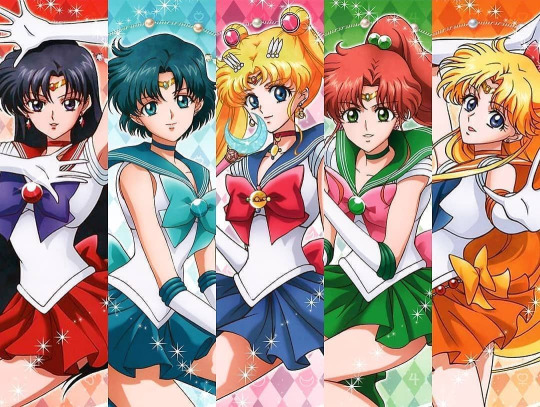

And even then, I should have liked it if Jupiter’s antenna was always on display as it is just something I always found cute in the manga, I liked Mars’ five point star earrings better in the 90s, and I like how in the 90s, each of the Inner Guardians’ sailor stripes were a little different.
Of course, this is all my opinion. I would like to hear which of the animes did Sailor Moon right in your opinion and why. Thanks for reading and stay safe, and have a great day.
#sailor moon anime#sailor moon reboot#sailor moon crystal#sailor moon eternal#pretty guardian sailor moon#pretty guardian sailor moon crystal#bishoujo senshi sailor moon#90s anime#sailor moon 90s#character development#storytelling#quality#critique
53 notes
·
View notes
Text
Lemongrab 1 headcannons (long)

(I tried to group these around the theme of free time/hobbies)
🍋 After like… 3 days of not being in the candy kingdom after he was relocated to the earldom he was bored out of his mind and did all sorts of bonkers stuff to entertain himself. Like try to build a parachute out of old sheets and jump out of the highest window, or go surfing down the stairs on an ironing board. Does he seem like the sort of person who should be left unsupervised? No. It’s a wonder he didn’t die doing all the dumb things he got up to.
🍋 at some point Lemongrab probably built himself a playground in the empty courtyard in his castle so he could entertain himself and have fun but either lost interest half way through building it, or burnt all the things down one by one in anger after he hurt himself playing on them. Like he fell off the swing and decided the only way to make it pay for this humiliation is to blow it up, and accidentally Ka boomed everything else along with it.
🍋 Too Young showed that Lemongrab is far sighted and can’t read properly or see things clearly up close, so he didn’t read books at all and instead preferred to watch films. And if he did read books he’d have to use a magnifying glass as his reading glasses didn’t seem to help him much (he still squinted and leaned forwards).
🍋 His infallible recall meant that after he’d watched something he could recite it off by heart, so he would destroy any film copies he has, which is why his castle is empty. Libraries and dvd rentals hate him. He is banned from every single dvd rental in Ooo.
🍋 he probably went through a phase where he tried to make his own films but none of them were very good and he didn’t have the focus to finish anything. All of his works such as the Comedy film “man with phobia of food gets job at a restaurant” which is just Lemongrab wearing a chef hat standing in his kitchen screaming at different vegetables for 2 hours straight, are all lying somewhere in the attic.
However it was a lot of fun for him and as he made lots of films he became pretty good at it. This is why he has the necessary equipment to make his propaganda in the Lemonhope arc, and why his propaganda is pretty good in terms of actually film quality. I mean we have a slow panning scenic shot at the beginning, flawlessly executed voice over, and fast cuts of the lemon people set against him talking as well as text overlay, fading shots, and background music. Fella clearly had film making talent if nothing else.
🍋 When the lemon people were made he would force them to star in his films alongside his brother.
🍋 On the subject of art, Lemongrab 1 also seems to be a pretty talented artist. I mean in one of the advtime comics Marceline organises a zine made up of comics drawn by the other characters and Lemongrab’s submission looks like this.

And as you can tell from the shading and the composition and his colour choice, while he definitely has a bit of a way to go, he’s actually really good at drawing. So I imagine lemongrab 1 really liked drawing pictures though given his horrible eyesight he probably had to use a magnifying glass to correct his vision.
I’d also like to add that Lemongrab 1 using sound effect symbols in the third panels implies that he knows what those mean, which he’d only know from reading comics. So he’s secretly a comic book fan.
And when you think about it his infallible recall would give him a huge visual library. If he can remember a map from just glancing at it then he can probably flawlessly copy it, and was therefore a really good realistic artist with a bit of practice.
🍋 One of the other hobbies he picked up was engineering and science, which he mainly attempted in the hope of making his mother proud of him. He designed the sliding doors and reconditioning chamber in his castle,and also made the torture devices in his dungeon as well as various robots that do completely dumb and pointless things.
🍋 One of these was a soft cloth robot that was designed to be physically affectionate with him and act as a surrogate mother of sorts but couldn’t get it to fulfill his precise demands so he destroyed it in a hissy fit.
🍋 he generally got a lot of his engineering ideas from Pb’s experiments and inventions that he’d seen lying around her lab or seen blue prints of when he went over to spy on her. He’d copy her but put a lemon twist on her stuff.
For example, the pink lemonade lemon sea
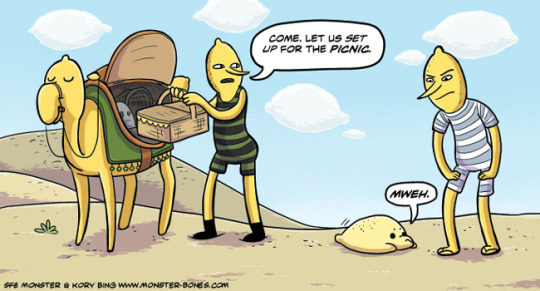
we see in the lemon sea comic was made using the same technology as the butterscotch lake Pb made for uncle gumbald. But with a bomb instead of a grenade.
🍋 Because he made the pink lemonade sea he was the one who made all the aquatic lemon creatures we see in that comic. He was really excited that his lemon sea would finally have an ecosystem he forgot he had only a vague idea of how fish work, so there’s penguins and lemon coral reefs in the same place and it’s all very inconsistent.
🍋 He also quite enjoyed gardening and growing trees. Mainly because lemons are the only food he can really eat properly, and also because trees... are fun. He was especially interested in tree sculptures (which is when you grow trees into certain shapes) which is what the tree in his throne is all about.
The reason it looks like that is because it’s a sculpture in process- the finished thing would be a tree throne. It was, however, never finished as he cleared most of his projects out before Too Old.
🍋 Lemongrab actually quite likes a lot of music, he just hates harps as he has upsetting memories associated with them as I’ve explained here.
Lemongrab's favourite types of music were genres that had "screaming" in them. So stuff like heavy metal, opera, yodelling. He had pretty eclectic tastes but punk music was his favourite because the defining mood of that genre is anger, which he can obviously get behind.
Also Punk vocalists tend to not have conventionally nice sounding voices when they sing. Like screaming, snarling, and ranting more than singing are typical punk musician features. In other words, kind of like Lemongrab. So the first time lemongrab ever heard someone who sounded like him was listening to punk music, and I imagine it brought him a bit of comfort
🍋 On the subject of music, as he liked punk music he would’ve run into Marceline and the scream queens sooner or later. While he has mixed feelings about Marceline due to her being his mother’s ex girlfriend he really enjoyed a lot of her music
Lemongrab’s favourite Marceline song was I’m just your problem as it’s as a song about dealing with not being enough for someone- that someone being Pb SPECIFICALLY. Lemongrab heard the line “I’m sorry I’m not made of sugar and I’m not sweet enough for you” and became a groupie on the spot.
🍋 He even went as far as to write his own fan cover called “I’m just your problemon” which bore no resemblance to the original song beyond the title and was just Lemongrab yelled about his mummy issues for an hour with out of tune guitar in the background. There is still a very poorly made recording of it up in the attic.
17 notes
·
View notes
Text
Module 10: Kertesz and Cartier-Bresson versus Smith and Salgado
Compare the work of Andre Kertesz and Henri Cartier-Bresson versus the work of Eugene Smith and Sebastião Salgado. They are four photojournalists with different approaches.
– What are the main differences and similarities?
– What’s the better journalistic approach?
Similarities Differences Andre Kertesz
&
Henri Cartier-Bresson
Black and White photografies.
Humanistic photographer, photo essay
They did not accept changes in their photos.
They want to tell a story with their photos.
They both believed that the photographer needs to be invisible to the subject for capturing the decisive moment.
Kertesz influenced art along with journalism
Bresson pioneered street photography, specialises in candid photography
Eugene Smith
&
Sebastiao Salgado
Black and White photografies.
Their photos are focused on sad subjects and facts, evoking emotions.
They want to tell a story with their photos.
They do not like to make changes in their pictures using the dark room.
Smith developed photo essay into a sophisticated visual form
Salgado does not believe that he is a photojournalist, but a social photographer
Andre Kertesz
Born in Budapest, Hungary, in 1894, Andre Kertesz worked as a clerk at the Budapest stock exchange in 1912 when he bought his first camera. Two years later, he was sent off to World War I, when he was 20 years old and picture that miserable and hard life and shared with the world.
It was in 1925 when he moved to Paris because of a lack of opportunities and started to work as a freelance photographer. (Albers, P. 2015)
In 1928 he participated in the First Independent Salon of Photography, where his pictures were notably for his blend of a romantic sensibility with modernist attitude. He was cited by critics and mentioned as a proof that photography could be considered a fine art.
Kertesz published three books with his photographs. Immigrated to the USA in 1936 and settled in New York, where he started to work for House and Garden magazine as a professional photographer. At the age of 60, he retired and started to focus on more personal topics that he used to enjoy when an amateur photographer.
Kertesz is known for his the visual lyricism and humanism that characterized his practice. His camera angles are different, with height and depth. His photos are mostly in an urban scenario.
“I always had a small camera with me on the front line, where I made candid, informal photographs, unlike the official photographers for the War Department. They always came with a huge camera on a tripod after the battle was over to make a scenic photograph that would show the destruction” (Andre Kertesz) (Course Notes Module 9).
Henri Cartier- Bresson
Henri Cartier- Bresson was born on August 22nd in Chanteloup, Seine-et-Marne. He studied at the Lycée Condorcet, Paris. He studied painting under André Lhote. In 1926 he took his first photographs. In 1931 he saw a photograph by Martin Munkácsi in the arts magazine Arts et Métiers Graphiques and decides to focus on
photography.
In 1932 he bought his first Leica and travelled across Europe with his friends Leonor Fini and Pieyre de Mandiargues. First publications in Voilà and Photographies.
He had his first exhibition at the Julien Levy Gallery, New York in 1933. His photographs are subsequently shown at the Ateneo Club in Madrid.
From 1935-39 he worked for cinemas before moving to war photography in 1940. He joined the “Film and Photography” unit of the Third Army in 1940. Taken prisoner by the Germans on June 23rd. After two failed attempts successfully escaped on his third attempt in February 1943. He worked for MNPGD, a secret organization created to help prisoners and escapees.
He took a series of photographic portraits of writers and artists in 1944 for Editions Braun (Henri Matisse, Pablo Picasso, Georges Braque, Pierre Bonnard, Paul Claudel, Georges Rouault).
In 1947 he held a photo exhibition at the Museum of Modern Art in New York. Creates the cooperative agency Magnum Photos with Robert Capa, David Seymour (Chim), William Vandivert, and George Rodger. From 1948 to 1950, he spent three years in the Far East: in India for the death of Gandhi, in China for the last six months of the Kuomintang and the first six months of the People’s Republic, and in Indonesia for its independence. His photographs are published all over the world.
1952: His first book, Images à la Sauvette, with its cover by Matisse, is published by Tériade. The first exhibition in England, Photographs by Henri Cartier-Bresson at the Institute of Contemporary Arts.
In 1954 he is the first photographer allowed in the USSR since the beginning of the Cold War.
Later he travelled to China, Mexico, India, France, the USA and USSR from 1955 to 1973.
In 1974 he decided to focus again on drawing and resigned from Magnum Photos. (HCB foundation )
He believed that the photographer needs to be invisible to the subject for capturing the decisive moment. He said, “life is once forever” by which he meant that once the decisive moment has passed, it can never again be repeated. Every minute occurs once and after it is over you can do nothing about it.
He had said that staging your subjects to get a perfect picture is unethical. He thought that was the basic rule of candid photography. But many of his own photographs were posed. Henri Cartier- Bresson admitted that capturing one image to depict the event is very difficult. Therefore, he practised photo essay to capture the entire event from various perspectives.
Similarities with Andre Kertesz:
They both believed that clicking the decisive moment is important. They did not care about the technical aspects of photography. They both did not think of photography as a way of reporting things.
(Lessons W Eugene Smith taught me about photography, 2013)
The Decisive Moment: “To me, photography is the simultaneous recognition, in a fraction of a second, of the significance of an event as well as of a precise organization of forms which give that event its proper expression” (Salgado, 1990, p.147).
In 2000 he set up the Henri Cartier-Bresson Foundation with his wife, Martine Franck, and daughter, Mélanie. The idea is to provide a permanent home for his collected works as well as an exhibition space open to other artists. And in 2002, The Henri Cartier-Bresson Foundation is recognized as being of public interest by the French State.
Henri Cartier-Bresson passed away in Montjustin, Provence on August 3rd, 2004. (HCB foundation )

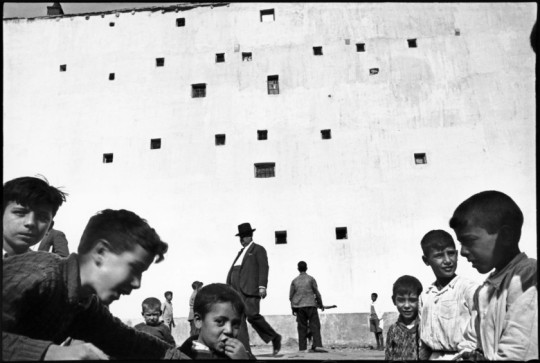

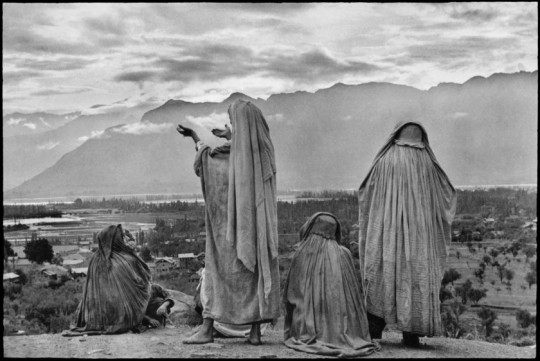
(Magnum Photos, 2014)
Eugene Smith
American photojournalist
Worked extensively and popularised photo essay
He was a humanitarian photographer
He always believed in having a purpose for clicking a photograph. This shows the focus that he had while photographing.
He wanted his photographs to convey an emotional resonance with his viewers.
He also wanted to change people’s view about war. He was ready to risk his life for clicking a photograph if people would realise the negative side of war and stop wars in the future.
He said that if a photographer does not know the answer to ‘why am I clicking this?’, then they should stop photographing.
Eugene Smith also tried to capture the reality behind the war. He photographed the lives of people who were a part of the war. This shows his humanitarian approach to photography.
Eugene Smith was considered by many to be aggressive in person but he always cared deeply for his subjects. He was always respectful to them. And if he found injustice being done to anyone, then he would like to photograph it and bring that topic to light.
Unlike Henri Cartier-Bresson, Eugene Smith thought that it was alright to stage photographs. If staging added authenticity of place to an image, then it could be used.
He used to print his photographs a number of times till he thought that the photograph looked fine to him. He always wanted to control the final image in post-processing. While Henri Cartier-Bresson did not post-process his images. He would get a trusted printer to do his work. He was more interested in photography.
He was never concerned about his finances, fame and recognition. He just wanted to do his job as best as he could.
(Lessons W Eugene Smith taught me about photography, 2013)
He also worked as a photojournalist war correspondent for Flying Magazine from 1943-44 and one year after that for Life magazine. He followed the American offensive against Japan when he got severely injured. He had to undergo surgeries for the next two years.
After recovering, he focused on making a number of photo essays that went on to become very popular.
His largest photo essay is of 1975 Minamata village in Japan. The entire fishing villages faced huge troubles due to mercury dumping be a chemical company.
(Howard Greenberg Gallery, 2018)
JAPAN. Minamata. Iwazo FUNABA’s crippled hand, a victim of the disease. 1971.
JAPAN. Minamata. Iwazo FUNABA’s crippled hands. She is a victim of the Minamata disease. 1971.
JAPAN. Minamata. Takak ISAYAMA, a 12 year old fetal (congenital) victim of the Minamata Disease, with her mother. 1971.
(Magnum Photos, 2014)
Some think that Eugene Smith was very hard on himself and sacrificed his health to concentrate on his career. He said that photography is everything for him and rest of the things do not matter that much. This lead to him passing away at the early age of 59 due to a heart stroke. He left behind $18 in his bank account and tonnes of photographs which continue to inspire photographers to this day.
(W. Eugene Smith Memorial Fund, 2004-2017)
4. Sebastiao Salgado
Sebastiao Salgado was born on February 8, 1944, in Aimorés, Brazil. A region with no access to a good education, which made him travel about 180 kilometres until Vitoria, for schooling. Salgado attended one of the best universities in Sao Paulo and got his MA in Economy. He also got married to Lelia Wanick and had two children with her. Today he is an award-winning photographer known by his arresting documentation of communities around the world.
Salgado has a monochromatic style, he believes that it forces his viewers to focus on the pictures’ topic, other than colours. His style combines complexity with a high sense of drama, and his work is dedicated to awareness of conditions of both wildlife and humans. Salgado’s photography has often focused on the effects of hardship, poverty and oppression on people of various cultures, and with the effects of industrialization on the natural landscape. Inspired by the photojournalism of Lewis Hine, W. Eugene Smith and Walker Evans, Salgado has tackled subjects like famine, poverty and social inequality in black-and-white photos that are unsparing yet often beautiful.
Salgado has earned fame for his stark photos of people coping with the effects of poverty, famine, industrialization and political oppression. He has received numerous awards for his photojournalism and has twice been named Photographer of the Year by the International Center of Photography. He and his wife founded the photographic agency, Amazonas Images and co-founded the environmental education centre, Institutio Terra that works on the restoration of Brazilian rainforests.
“My pictures gave me 10 times more pleasure than the reports I was working on. To be a photographer was, for me, an incredible way to express myself, an incredible way to the see the world from another point.” (Sebastiao Salgado)
– What’s the better journalistic approach?
It is true that the path of these four artists was not easy and all of them are inspiring, creative and good examples of photojournalism photographers. They wanted to tell people a story and they did it very well. Despite all that, we came up to a conclusion that Andre Kertesz and Henri Cartier-Bresson’s way of working is better. They follow the code of ethics in journalism, and their pictures are exactly what the real moment was, no changes, the real life and the real fact.
References:
Albers, P. (2015, March 27). André Kertész. Retrieved April 1, 2018, from https://www.britannica.com/biography/Andre-Kertesz
BIOGRAPHY (2014, April 02). Sebastiao Salgado. Retrieved April 03, 2018, from https://www.biography.com/people/sebastião-salgado-40046\
Course Notes Module 10. “Presenting the moment: Eugene Smith and Sebastiao Salgado” (2018).
Course Notes Module 9. “Capturing the moment: Kertesz and Cartier-Bresson” (2018).
Getty Museum. (n.d.). André Kertész. Retrieved April 1, 2018, from http://www.getty.edu/art/collection/artists/1847/andr-kertsz-american-born-hungary-1894-1985/
HCB foundation . (n.d.). Biography. Retrieved from henricartierbresson HCB foundation : http://www.henricartierbresson.org/en/hcb/biography/
Howard Greenberg Gallery. (2018). W Eugene Smith. Retrieved from Howard Greenberg Gallery: http://www.howardgreenberg.com/artists/w-eugene-smith
Kim. E. (2015, March 02). 5 Lessons Sebastião Salgado Has Taught Me About Street Photography Retrieved April 1, 2018, from http://erickimphotography.com/blog/2015/03/02/5-lessons-sebastiao-salgado-has-taught-me-about-street-photography/
Lessons W Eugene Smith taught me about photography. (2013, May 13). Retrieved from Eric Kim Photography: http://erickimphotography.com/blog/2013/05/13/7-lessons-w-eugene-smith-has-taught-me-about-street-photography/
Magnum Photos. (2014). Henri Cartier- Bresson: Portfolio. Retrieved from Magnum Photos: https://pro.magnumphotos.com/C.aspx?VP3=SearchResult&ALID=2K7O3R14TE52#/SearchResult&ALID=2K7O3R14TE52&VBID=2K1HZS2RBPID4&POPUPIID=2S5RYD1EZGYV&POPUPPN=50
Magnum Photos. (2014). Portfolio- Japan.1971.Minamata vs. the Chisso Corporation W. Eugene Smith. Retrieved from Magnum Photos : https://pro.magnumphotos.com/C.aspx?VP3=SearchResult&ALID=2TYRYDDWZXTR#/SearchResult&ALID=2TYRYDDWZXTR&VBID=2K1HZS2O2M5AO&POPUPIID=2S5RYDY592XK&POPUPPN=17
Salgado, S. (1990). In Galeano E. H., Ritchin F. and San Francisco Museum of Modern Art. (Eds.), An uncertain grace. New York, N.Y.: Aperture Foundation.
The Art of Photography. (2015, May 14). Sebastião Salgado Photographer (Brazilian). Retrieved April 1, 2018, from http://theartofphotography.tv/photographers/salgado/
W. Eugene Smith Memorial Fund. (2004-2017). W. Eugene Smith legacy. Retrieved from W. Eugene Smith Memorial Fund: http://smithfund.org/smith-legacy
Kertesz and Cartier-Bresson versus Smith and Salgado Module 10: Kertesz and Cartier-Bresson versus Smith and Salgado Compare the work of Andre Kertesz and Henri Cartier-Bresson versus the work of Eugene Smith and Sebastião Salgado.
0 notes